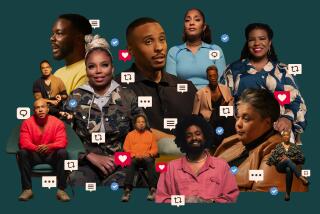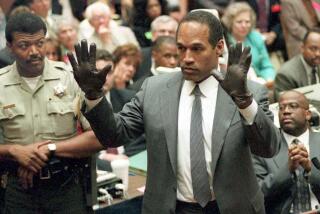What We See on the Tube Is an Out-of-Focus View of Young Blacks
- Share via
National television news can unravel presidential candidacies, make caricatures of Christians defending their God and give gang hoodlums instant star status. Similarly, local newscasts, which particularly pump the sensational during viewer rating periods, sometimes mislead viewers.
Young black men who walk the straight and narrow are victims of television feature stories that give free air time to young gangsters who, with the heady exposure of being manufactured into media limelighters, defend their violent codes, drug trafficking and anti-social behavior. Grotesquely characterized by braided or excessively curled hair, menacing stares and sing-song tones of mispronounced English words and ghetto slang, they are force-fed onto our television screens in the guise of giving the other side of the story.
In this instance the cliche “What you see is what you get” is translated to white middle America that all young black men are gangsters.
This television news interest can be linked to this year’s law-enforcement shakedowns of young black men who happened to be on any street in targeted Los Angeles areas, any time of the day or night.
Thus the irrational fear of young black men, always present in this country, has intensified. The older woman getting onto the bus is afraid to sit beside a young black man. The housewife going into the mom-and-pop store cringes near the door when she sees a couple of black teen-agers buying sodas at the counter. An elderly man taking his leisurely early-evening walk crosses the street rather than meet head-on several black youths on their way home from the gym.
Much was made of the appearance of the Rev. Jesse Jackson’s attractive, all-American-looking children at the Democratic convention. One noted network commentator even went so far as to refer to them, in near-astonishment, as “halfbacks and beauty queens.” Mainstream black parents simply saw them as extensions of their own children--families that work, play and worship together. But they were an oddity to white television viewers. Members of urban gangs are the real odd-men-out.
The pervasive image of the black “gang-banger” can have its subtle effect in the job market, too. A wary employer, though looking at a neatly dressed applicant, may not be sure whether he is a gang member in disguise or a genuinely straight-arrow kid. What the employer does know is that the applicant is black. Is the employer able to concentrate on the application form that shows high-school graduation and current college enrollment? Can he hear the intelligent words that bounce back to him during the interview conversation? The television image can prevail, and his resultant response may be “No openings today . . . maybe next month.”
Jobs for young people--typically as fast-food clerks, messengers and deliverers--are plentiful. The reality of getting the jobs, however, is limited. Gang members’ getting their “wants” while the good guys are denied their “needs” looks like evidence of another triumph of wrong over right.
Disillusioned young black men need shoring up. They must continue to believe that the American Dream is attainable for those who want it and work honestly to get it. All they want is to be placed ahead of bullies who are sought after and get global attention via TV exposure.
The insatiable public desire for sensational visual thrills should be satisfied at the movies. All the good guys want from the television news media is that reporting be accountable for the shaping of attitudes--whether in politics, religion or social issues. They must be the first to consider that negative stories can never become positive headlines.
In spite of the contest for television news ratings, some videotape footage of gangs--like that of international terrorists--is best left unseen.
More to Read
Get the L.A. Times Politics newsletter
Deeply reported insights into legislation, politics and policy from Sacramento, Washington and beyond. In your inbox twice per week.
You may occasionally receive promotional content from the Los Angeles Times.










